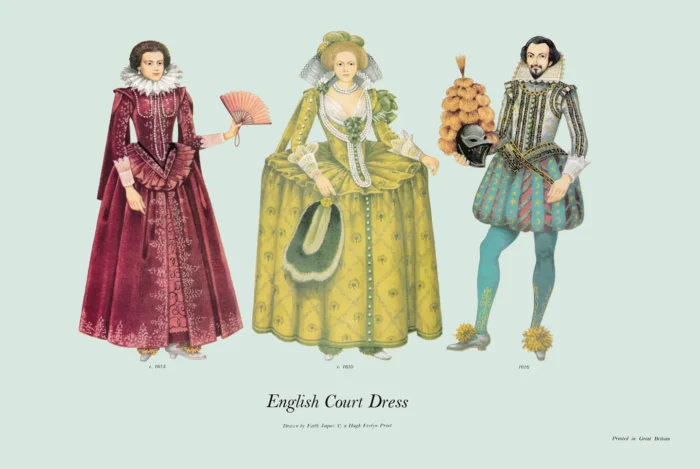English Court Dress, 1610-1616
£10.00
English Court Dress, 1610-1616 (scroll down for a more detailed Description)
Published 1968 by © Hugh Evelyn Limited; drawn by Faith Jaques
Size: c. 38 x 25.5 cm [15″ x 10″] may vary slightly from printers’ cut 50 years ago
Printed on medium cardstock weighing 151 g/sm2 faced in light greyish cyan – lime green (RGB: c. d8e8e0)
Print is STANDARD size – shipping is the same for 1 to 10 prints (based on largest print size in your order) – see Shipping & Returns.
In stock
- Satisfaction Guaranteed
- No Hassle Refunds (see Shipping and returns)
- Secure Payments
Description
Queen Elizabeth’s personality and influence were so strong that, in the absence of a good new idea, the exaggerated styles of the 1590s retained their popularity. France was no better as Marguerite de Valois was separated from the King, Henry IV and the new Queen Marie brought a great dowry but was a flashy blonde and perpetuated old styles. Elizabeth of Bourbon, married to Philip IV of Spain, looks quite different in her obsolete Spanish robes from her sisters (Henrietta Maria and the Duchess of Savoy) in portraits of the same time. The Spanish ignored current fashion and developed the framed, farthingale skirt into a pannier style. Everyone else wore softly flowing robes. Holland evolved a distinctive style for her professional class of merchants and judges which found favour in other Protestant countries but was never high fashion. Dutch and French engravers like Visscher, de Bry and Gaultier have left a record of different communities at various activities and the uncomfortable drum-farthingale was worn in France and Holland not only by rulers or their courts. Ugly English fashion may have been due to the Queen wearing such unbecoming garments. Her Queen-virgin approach encouraged women to copy the low-cut bodice. All young unmarried girls wore uncovered necks as Marguerite de Valois had. The huge farthingale gave a small figure added importance. Hooped panniers were retained into the 19th century so the drum farthingale survived as part of State robes. Anne of Denmark, Queen Consort to James I was told by her frugal husband to use up Elizabeth’s mighty and expensive wardrobe. The most noticeable change in women’s fashion was in the low-cut bodice and style of neckwear. Bodices were cut in a deep ‘U’ shape and filled in with a very fine gauze partlet which turned back as a collar. To this was sewn beautiful lace or embroidered muslin in a large fan-shaped collar which had to be supported by wires or a band round the back of the neck. The silhouette was so uniform these collars afforded the only means of individuality. Even jewels were worn in a uniform manner, generally ropes of pearls caught on the shoulders and looped in one or three swags to a locket or rosette on the bosom. The last trace of the Spanish fashion can be seen in the vestigial hanging double sleeves. The big change in shape took place about 1607 when someone decided she could bear her hooped farthingale no longer and let out her bodice. This revolutionary step took place in England where, Skirts were gathered or pleated over small pads into a raised and less restricting waistline, and the circular pleated top of the farthingale became a frilled basque from the edge of the bodice. It was a long time before the stiff pointed stomacher was abandoned, and it became more pronounced in Flemish and Dutch costume. Elizabethans and Jacobeans delighted in entertainment. It was a theatrical age and the clothing of the gentleman would be a costume for that – hence the old-fashioned cut of his paned breeches against a modern jerkin with its raised waist, fitted sleeves and whisk collar. As women retained their old styles for court dress, certain men’s clothes remained conservative for official occasions. Soldiers and anyone connected with fighting wore the full, paned breeches that came into fashion at the beginning of the 16th century. The sun, moon and stars embroidered on the panes are often indicative of the love of symbolism these cultivated people indulged in. If worn for a tournament the whole outfit would be covered by armour with the feathered helm crowning all. With shorter dresses there was more emphasis on shoes and all the figures here wear heels introduced in the 1590s and were popular so became constant fashion as were the doggy rosettes on the straps.
Additional information
| Dimensions | 38.1 × 25.5 cm |
|---|




